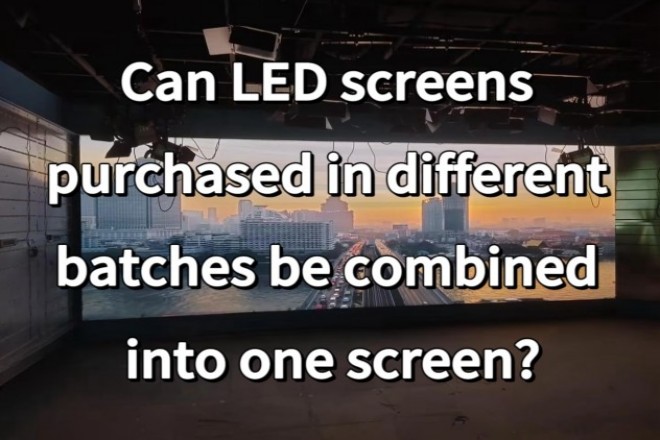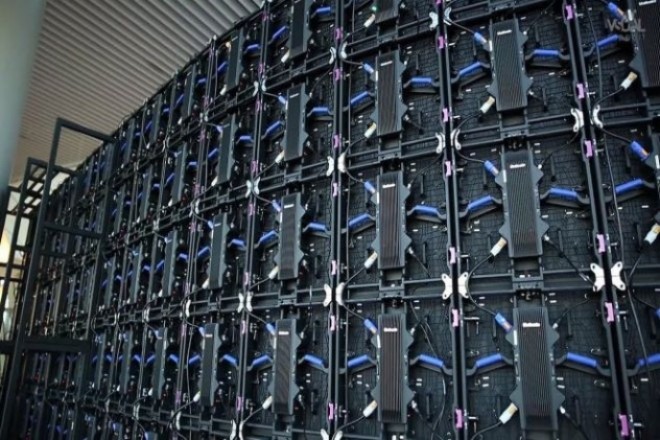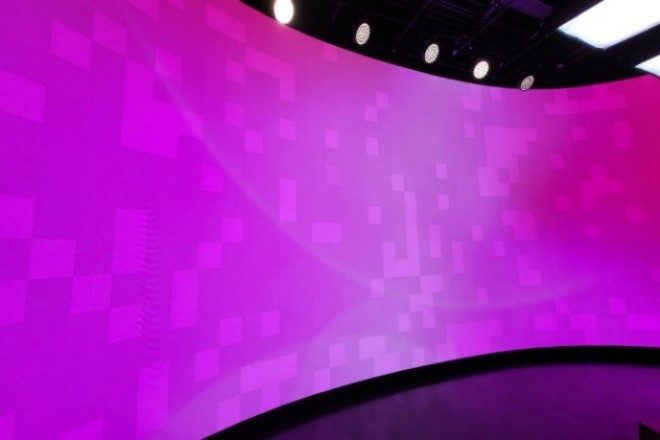介绍

LED屏幕 have always been very popular in the market as an excellent visual display and advertising display device.
Many people need to purchase LED screens in batches due to various factors, such as insufficient budget, time, or technology iteration.
Then a question arises: Can LED screens purchased in different batches be combined into one screen?
Of course it is possible, but there are some minor issues. What are they? You will find out after reading this article.
1. Brief introduction to the splicing technology of LED screens

LED screen splicing technology, to put it bluntly, is to put several small LED screens together to form a super large screen, which looks both shocking and high-definition. This technology is now very popular, whether in a busy commercial street or at a large concert or conference, you can see it.
For example, you have several small puzzles in your hand, each of which has a different part of the picture drawn on it. When you put these puzzles together in a certain order, a complete picture appears.
This is the reason for LED screen splicing, except that the “puzzle” here becomes an LED screen, and the “picture” is what you want to show. By splicing, you can get a super large screen that can play high-definition videos, and gorgeous pictures and even display data in real-time!
1). So, what do you need to prepare for splicing?
These are the “puzzles” of splicing! Each module contains a bunch of small LED lamp beads, which are responsible for emitting light and displaying.
The size, brightness, and color performance of the module are very important, and they directly determine the effect of the large screen after splicing.
- Splicing frame:
Just like a puzzle needs to be placed on a stable table, the LED screen also needs a stable frame to support it. This frame must not only be able to fix the screen but also ensure that the screens are tightly spliced together so that it looks like a complete screen.
- Signal line and power line:
These are like the “blood vessels” of the splicing screen, responsible for transmitting data and power. High-quality wires can ensure stable signal transmission and sufficient power supply so that the large screen always maintains good working conditions.
- Splicing control system:
This is like the commander of the splicing screen. It is responsible for receiving signals from computers or other devices and then distributing these signals to each screen module, allowing them to display content according to instructions. This system must be very precise to ensure that each screen is displayed just right.
- Splicing processor:
This is a high-tech gadget that handles complex image problems, such as how to make the splicing between screens look more natural and how to adjust the brightness and color of each screen to make them look more coordinated. With it, the effect of splicing screens will be taken to the next level!
- Content management software:
This is like an “editor” for splicing screens. You can use it to create and edit the content you want to display, such as videos, pictures, text, etc. The software interface is usually very intuitive, and even if you are not a professional, you can easily get started.
2. Can LED screens from different batches be spliced together?

LED screens from different batches can be spliced together, but be aware that there will be color differences.
Due to the possible differences between batches, the splicing effect may be affected to a certain extent. The following is a specific discussion on the impact of batch differences on splicing:
1). Possible problems with batch differences
- 色彩表现:
Speaking of splicing LED screens from different batches, that is really a challenge.
You have to know that different batches of screens may have different colors due to various small changes in the production process, such as LED chips, packaging processes, and phosphors.
In this way, after being put together, the colors may be colorful and look uncoordinated.
- 亮度 均匀性:
Brightness uniformity is one of the important indicators to measure the quality of LED display screens. There may be differences in brightness between different batches of screens, and even within the same batch, the brightness between different modules may be different.
This difference may be more obvious after splicing, resulting in uneven overall brightness of the display screen. In this way, the entire screen may be bright and dark in one piece, like a big clown face.
- Physical size:
Although the screens are produced according to specifications and standards, there may still be a little difference in size between different batches.
Although this difference is small, it will be troublesome when splicing. It may cause gaps between the screens or uneven splicing, which is uncomfortable to look at.
2). Suggestions and measures
首先, you have to check each batch of screens carefully before splicing. You have to use professional equipment to carefully measure whether the color, brightness, and size meet the requirements of splicing. If there are problems, quickly remove them and don’t let them mess up.
然后, you can try point-by-point correction technology. This technology is very powerful. It can collect and correct data for each pixel so that different batches of screens are as close as possible in brightness and color. Although the difference cannot be completely eliminated, it can at least be reduced a lot.
还, manufacturers have to work hard. They should use a unified production plan and raw material formula to ensure that the quality of each batch of screens is similar. During the production process, every link must be strictly controlled to prevent pollution and loss of control from affecting the quality of the screen.
Of course, these measures can only minimize the impact of batch differences on the splicing effect and cannot completely eliminate it. So, splicing different batches of LED display screens still depends on the specific situation, and sometimes, you may have to accept a little imperfection. But in general, as long as we do it with our hearts, we can still do this beautifully!
3. If you must splice, what are the precautions and challenges?

Alas, to be honest, it is not an easy task to put together LED display screens from different batches. You have to pay attention to many details. Let’s talk about this below.
1). Detailed inspection and screening:
Before splicing, you have to “examine” each batch of LED display screens. This is not just a casual look; you have to use professional equipment to measure it. The key is to see if their color performance is consistent, whether the brightness is uniform, and whether there is any difference in physical size.
色彩表现: You have to see if each screen is equally bright when displaying the same color and whether any screen has a color cast.
亮度均匀性: Check whether the brightness of each screen is the same and whether any of them is particularly bright or dark.
Physical size: Use precise measuring tools to measure the size of each screen to see if there is a slight difference.
If you find a problematic screen, pick it out quickly; don’t let it ruin the whole pot of soup.
2). Color and brightness correction:
Screens from different batches may have differences in color and brightness. At this time, you have to use professional color and brightness correction tools.
Correction tools: These tools can help you accurately adjust the color and brightness of each screen so that they look as similar as possible.
Correction process: You have to adjust it little by little and compare it repeatedly until you are satisfied. This requires patience; don’t rush.
3). Accurate measurement and adjustment:
Before splicing, you must also accurately measure the size and installation position of each display module.
Measure the size: Use accurate measuring tools to measure the size of each screen accurately without any error.
Determine the position: According to the splicing design, determine the installation position of each screen to ensure that they can be tightly spliced together.
Adjust the gap: If you find gaps or uneven places, you must adjust them quickly to prevent them from affecting the overall effect.
4). Use high-quality splicing materials and processes:
The materials and processes of splicing are also very important. They are directly related to whether the spliced display is stable and durable.
Choose materials: Choose those with good quality and durability, and don’t choose inferior products to save money.
Construction technology: Find a professional construction team to do it. They are experienced and can ensure the quality of splicing.
5). Reserve maintenance space:
When splicing, don’t forget to reserve enough maintenance space.
Consider maintenance: If there is a problem with any screen in the future, you must be able to easily remove it for repair or replacement. Therefore, you must leave some space when splicing and don’t crowd it.
合理设计: When designing the splicing, take the maintenance space into consideration so that it will be much more convenient to maintain in the future.
结论
In short, although there are many challenges in splicing different batches of LED display screens, through careful planning, professional technology, and continuous maintenance, we can fully achieve stable and high-quality display effects.
With the continuous advancement of technology, the splicing process will be simpler and more efficient, opening up more possibilities in the field of visual display.
最后,如果你想了解更多关于LED显示屏的信息, 请与我们联系。
Of course, what if you just want to replace the module because it is broken but don’t want to see the screen distortion? In fact, this is easy to solve.
If your LED display supplier is professional enough, he will definitely prepare enough replacement modules for you when you buy the LED display, so that you can replace the broken module that was accidentally damaged.
Just like in our case, the number of spare modules will be noted:
